Walt Disney Pictures (2005, 2007, 2008, 2009), Walt Disney Home Entertainment (November 8 2011), Individual 3-disc Blu-ray and DVD Combo Packs include 3D Blu-ray and Blu-ray Disc plus DVD (4-disc Bolt also contains Digital Copy), original supplements included, 1080p high-definition widescreen, DTS-HD 5.1 Master Audio, Retail: $44.99 each (Bolt: $49.99)
Storyboard:
Four animated 3D reissues offer a unique look at the changing face of Disney Animation throughout the period of switching from traditional hand-drawn features to CGI, the arrival of John Lasseter, and the outside influence of live-action/animation combination family comedies…

Chicken Little: The sky really is falling in Disney’s high-tech and in-your-face retooling of the classic story, which throws out the whole original plot and bundles in some alien invaders and enough mayhem to ensure that, hopefully, something will stick and the cracks won’t show.
Meet The Robinsons: Young orphaned inventor Lewis spends a day with a mysterious kid from the future, Wilbur Robinson, to put right what once went wrong, in a high spirited, at times messy, but unexpectedly emotional adventure.
Bolt: The star of a hit animal action adventure series finds himself a real life underdog when a location break-out goes wrong and he’s left to fend for himself in the real world…without any of the super powers his possesses on his show.
G-Force: Get ready to suit up with a team of elite…guinea pigs!? That’s what the G in G-Force stands for, as this miniature crew of crime fighters, armed with an array of international espionage foiling gadgetry, take on a billionaire industrialist about to unwittingly unleash a technological threat on the entire world!
The Sweatbox Review:
Disregarding Disney’s initial experimentation with animated 3D presentations for a handful of short subjects in the 1950s, the earliest of the Studio’s features to get the extra-dimensional treatment will be 1989’s The Little Mermaid, set for theatrical reissue in September 2013. Before that, we’ve already seen recent super-perspective conversions for Beauty And The Beast and The Lion King, which made half-decent arguments for traditional animation to be seen in this way (though sparingly, please; there’s no reason to start retrofitting the golden age classics, which would be tantamount to using the colorization process, although I wouldn’t say no to a new Fantasia, not that it would ever happen).
But it’s actually native three-dimensional imagery that visually works best to the format’s advantage due to the inherent nature of the fully rounded elements, and although a conversion for The Nightmare Before Christmas gave us a not entirely inappropriate ViewMaster feel to the look of the film, the likes of the impressive Tangled proved that CGI was perhaps the best medium suited to the format. Following Blu-ray 3D releases for their recent animated pictures (released, as in theaters, with both the regular flat versions and with the extra-D), Disney continues to be the main proponent of the BD3D format, now going back to update their combo packs of originally released theatrical 3D titles to present these editions in the home.
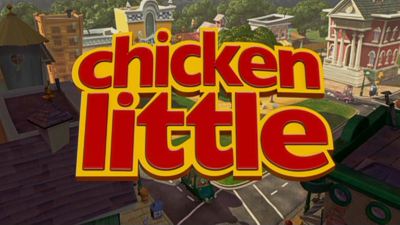
Chicken Little (81 mins, 1.78:1, Rated G)
When it arrived in theaters in 2005, Disney’s animated re-telling of the classic fable carried the tagline “Chicken Little, Movie Big”. How true that was, both for fans awaiting the Studio’s long-in-the-making return to classic stories and for the Mouse House itself, seeing as this was their proving ground on a completely computer animated movie away from Pixar. It was also a milestone turning point from Disney’s traditional hand-drawn style, and the film that, more or less, showed Pixar that the old hands could still pull one out of the hat and do quite well on their own – although its reputation hasn’t survived as much as others in the Disney canon, don’t put it pass this little bird that Chicken Little didn’t play a part in The Mouse and The Lamp’s eventual marriage.
The artists themselves did pretty well, having had to largely learn to draw all over again with a mouse of a different kind, and Chicken Little made its point well enough, the new technique on a story usually reserved for good old-fashioned cartooning marking itself out as a different kind of bird from the outset. To go with all the fancy new visual tricks, the plot gets an upgrade too – this is not the Chicken Little we remember from our childhood or even from Walt’s own short version of the tale from the 1940s. Using the age-old “sky is falling” routine as the film’s opening, Chicken Little quickly dispenses with the whole thing and goes for high-tech, high-concept gags, seemingly making the whole thing up as it goes along.

From the start it’s clear that our feathered protagonist Chicken Little is despised among the inhabitants of animal town Oakey Oakes for creating a fuss with his original ruse, but we soon learn that pieces of the sky are in fact dropping like bits of space-ship projected hexagons – because they are space-ship projected hexagons! Chicken is torn between trying to tell his friends Fish Out Of Water, Abby Mallard and Runt Of The Litter the truth, while also trying to live down the initial incident and making things up with his father Buck Cluck, who loves his kid but learns himself that he must trust him when the aliens eventually show. Of course, all comes right in the end, but to reveal any more would spoil what slim plot there is.

And that’s pretty much Chicken Little’s problem; there isn’t much that actually happens. It’s all fun in a knockabout, loud and wild way, but there isn’t much substance. The moments between Buck and his son are somewhat touching, but there’s at least two too many of them and they have the undesired effect of stop-starting the pace of the movie. When it’s good, such as in the opening scenes (although after an unappealing “how to open this movie” bit which falls flat and leans yet again, and too strongly, on the public’s love of The Lion King), it’s very good. But when it stammers, it feels the product of too much executive level interference. More than once, one can almost hear the request of one such person asking for a vocal gag to be added (hint: they’re usually the predictable, unfunny lines).
Chicken Little also doesn’t really know if it’s a DreamWorks-esque Fractured Fairy Tale along the lines of Shrek, or if it’s trying to be good clean Disney fun. Being a CGI movie, we get ample amounts of comedy, pop-culture references (wherever else are you going to see a live-action clip of Harrison Ford as Indy – strangely not being shown in ratio – turn up in a Disney animated film?) and contemporary songs (well, contemporary a few years ago, but never deny the Mouse to mine that Queen catalog one more time)! The film had been in production for a good few years, going through director and story changes, and even a central character gender switch (Chicken Little was, at one point, a girl to be voiced by Mrs Incredible, Holly Hunter)!
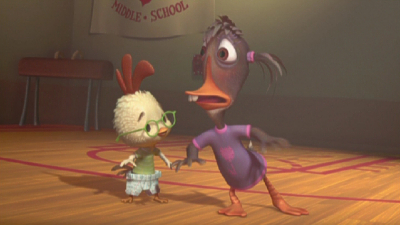
As with The Emperor’s New Groove, another film that he came in and “rescued”, director Mark Dindal eventually steered Chicken Little through these choppy waters to being a fairly enjoyable romp, but nothing that really sticks in the mind. Indeed, I originally saw the film in its 3D theatrical presentation (which, I have to add, did nothing for me other than reflect the theater’s “Exit” signs in the Little specs given to the audience) and came out almost not remembering a thing about it! Seeing it again naturally refreshes the memory, but the frenetic pace, hyperactive characters and comical alien intrusions still remind me of a simpler and slightly more fun movie: Jimmy Neutron, Boy Genius.
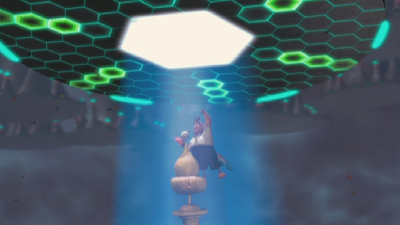
It’s not that Chicken Little isn’t entertaining, but from its inception to its marketing, it just seems a little confused, something reflected in Chicken’s character himself. Voiced by Scrubs’ Zach Braff, I found the voice to be too mature for the little chicken of the story, especially as he still seems to be in high school. Then again, the posters – and the cover art here – have him dressed up in a super cool suit, Men In Black style – surely the clothing of someone almost twice his supposed age? The other voices work much better, and it’s great to hear Don Knotts in his last role sounding so spot on as the Mayor, Turkey Lurkey. Director Garry Marshall scores as Buck Cluck, even though the writing for his character isn’t the strongest in the picture, while Wallace Shawn plays another of his irritable school principal roles.
Serial animation vocalist Patrick Warburton offers his usual blend of slightly sarcastic but innocent delivery, still sounding fresh here before over-milking that approach for every job since, while 1960s Batman Adam West turns up in the film’s closing in a parody of everything we’ve just seen, regurgitated big, Hollywood movie style. And that again is another problem – everything seems derived from voices, jokes and ideas we’ve all seen and heard before, even back in 2005, and this over-the-top movie recreation at the end feels strongly reminiscent of Tim Burton’s similar prank at the end of Pee-Wee’s Big Adventure. For a G-rated movie, there are also some mysterious themes (a Streisand-loving pig?) amongst its ultimately schizophrenic and indeed totally insane at times duration.

On the plus side, at least the animation is easily up to scratch, as one would expect from this particular Studio, and it has a nice cartoony feel that wouldn’t return until last year’s Tangled. Especially good is Mayor Lurkey – just watch his face even when he’s not sprouting Knotts’ lines! Taking a traditionally styled approach to the production design, the artists have fun in their imaginative world, which has seemingly jumped from the classic cartoons of the 1940s into the three-dimensional computer space of today and, keeping with the kid-friendly tact, colors are bright ‘n’ shiny, and even the duller shades have a vibrancy about them that almost glows.
Over time the film has become somewhat forgotten in Disney’s recent line-up, but as it unspools Chicken Little is quite a hysterically enjoyable diversion. Perhaps because I haven’t seen it in a while, and perhaps because expectations were lowered, I actually found some parts pretty funny, even if this never feels like a classic Disney movie. As a final touching sentiment, the film is dedicated towards the end of the credits to legendary animation storyman Joe Grant, who passed away during production, and though there are much worse (and many better) Disney films that could have served this honor, I’m sure the great man would be proud that his contributions continued at the Studio for so long and in to the new animated world of CGI techniques.
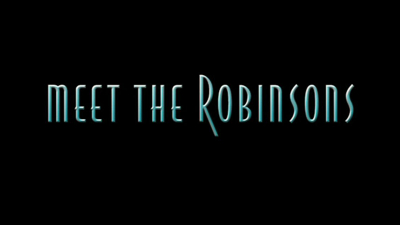
Meet The Robinsons (95 mins, 1.85:1, Rated G)
I’ll admit to not enjoying Meet The Robinsons as much as many others did when I first encountered the movie in theaters. While it was a clear step back toward top form for the Disney Studios after the emphatically boisterous Chicken Little and had picked up good word of mouth, I honestly didn’t think that Disney’s artists – so long the dominant masters of their art form – could handle the complexities of a human based drama in computer animation. Chicken Little had been highly promoted – a visibility factor that Robinsons lacked – and seemed to show Disney following the spoof animation crowd rather than blazing the trails as they had done for so long before. Meet The Robinsons could be mistaken for another in this line of frenetic, whirlwind movies, and indeed that’s how it came across to me initially.

The story, loosely based around William Joyce’s book A Day With Wilbur Robinson, cooks up some suitably nutty ingredients: young Lewis, an inventor who isn’t the most popular of kids, is proving difficult to find adoptive parents for, not helped by the fact that his contraptions don’t always perform as expected on cue. Especially annoyed by this is his roommate, nicknamed Goob, kept awake each night when Lewis’ latest gadgets flip out. During the school science fair, Lewis’ creation is sabotaged by the odd and vaguely sinister Bowler Hat Guy, a man with no real name but a clear ambition: to screw up Lewis’ future at any cost. Help is at hand in the form of young Robinson, who whisks Lewis to the future to show the kid that he does indeed have a part to play. However, Bowler Hat Guy is on their trail, and he forms a plan to get Lewis stuck where he is forever, thus unravelling the past and giving him the chance to revenge his own lost childhood…
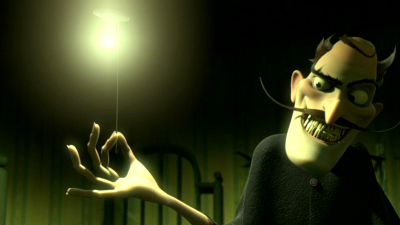
Now with a premise like that, you can’t put Meet The Robinsons in a box and call it a typical animated feature fare, but it does still fall into a couple of unfortunately contemporary conventions. The film begins purposefully slowly, in a refreshingly small and intimate way that will pay off enormously towards the end, when this opening takes on an emotional new meaning. On watching the film again, I’m more willing to set aside my issues with the future time-frame, where I did originally feel that the jump in time of roughly 20-30 years did not equate with the technological advancements depicted in the world. But I can’t reverse my feeling that the future is too hyper, which doesn’t lend itself any distinction in breaking away from the same feel of other CG features, in particular Blue Sky’s Robots, which I haven’t seen for a while and yet came rushing back to my memory during Robinsons’ second act (as a side note, author Joyce was involved in both).

The opening is great, if filled with typical Disney “believe in yourself” stuff, but when Wilbur comes along, Robinsons takes on his secretive, random characteristics, which aren’t all that likeable at first and quickly irritated me, though now of course I know it’s all to be explained later. But a moment with some big-band happy singing frogs still feels totally out of place for me in a world where other creatures retain their animalistic habits, and there remains, for me, no real heart in the future, which is what Meet The Robinsons really needed to ground the sheer lunacy of what were are being presented with. Crazy is all well and good, but it needs foundations and rules instead of simply collapsing into a mumbled jumble of one-liners and shouty voices that I thought were just loud, aggressively trying to be “funny”, and self conscious.
I’d liked how the future was depicted, with its many bouncy and inventive devices, though found the change in pacing at odds with the fairly laid back approach to life that the futurians have adopted. Again, however, the secret is to let things play out…and when that ending, a brilliantly gauged, wonderfully executed moment, comes along, it’s instantly clear that all the heart and emotion that the middle had been missing has been saved up for this ingenious third act. If any are familiar with the musical play Blood Brothers, the experience is somewhat akin to what happens on stage in that production. As most will tell you, it comes over as being pretty amateurish throughout, with many audience members leaving at the intermission, but then…the end comes, an event that hits you hard, and the first thing you want to do is go right back in and see it all over again.

That’s what happens here, with Meet The Robinsons. Just when I had started to question what had happened to all the good stuff at the beginning, we then meet the character of Cornelius, and somehow the whole film locks back together; he brings the required dramatic weight and super-injects a whole lot of heart that’s been missing. Then Lewis gets the trip he wanted and needed all along, and it’s played really, really well. One finally feels for the characters in a way we weren’t able to all along, and I don’t mind admitting that I even shed a tear, half for Lewis, and half in respect of the work that the artists pulled off in these final moments based on the great values of animation that Walt Disney created all those years ago.
Though once things have been given a chance to breathe for a moment the film once again strives to tie up its loose ends (Lewis finding a family, all the coincidences that occur in the last seconds of the film) neatly – too neatly – it all somehow works. And then we get the “Walt quote”, a page of text that embraces and encourages the message of the movie, and this touch just knocks me for six. Meet The Robinsons is all about its ending, the moment that compels an audience to go back and watch it right over again, and though it is sometimes a tough slog to get there, it truly pays off handsomely.
Most of the emotion in the earlier scenes comes from the lighting moods more than anything else, coupled with composer Danny Elfman’s unique score. He’s taken a wonderfully new approach here that strays away from what could be considered his “usual sound”, coming up trumps with an inventive score, complimented by others’ songs that follow the Pixar model of not having characters break into song, with a number of original tracks perfectly suiting their moments (including even the frogs’ big band “standards”). As one would expect, the Studio artists’ animation is uniformly excellent, apart from the occasional character, but again for such a bustling, crowded film it seems the “people police” were in force: a drawback that never seemed to be a problem in hand-drawn times.

The future especially – Todayland being the exceptional joke – is a complete diversion to the nitty gritty post-apocalypse styles of more heavy movies, and brighter still than even those “fun futures” we’ve seen in like-minded movies such as Back To The Future Part II and Bill And Ted’s Bogus Journey. But nothing particularly “wowed” me, including the Bowler Hat Guy, who had unfortunately had his best scenes revealed in trailers and clips. He’s a great, fun character, but does Bowler Hat Guy bring any worth to the picture? Again, the issue of grounding comes up, along with a wavering accent – given the background we’re eventually allowed to pick up on, why would he have a British accent? Director Stephen Anderson, adopted himself and bringing to the film a great deal of his personal understanding of an orphan’s experiences, voices the character himself – a bold move – and has suggested he has a British “influence”.
While it works for the character on screen, there’s no reason that he should be affected as such, nor even that he should wear that very icon of British institutionalism, the bowler hat, later revealed to be a mechanical device named Doris. Here again, the background story to the hat’s “character” doesn’t quite add up. It works, but I felt the threat could have been bigger and more of a build up to a proper showdown. I could have done with Lewis coming to a greater realisation about what he could do to stop Doris rather than just carry out the method of the hat’s destruction that he does. Doris really needed, and deserved, a slightly grander ending, with Bowler Hat Guy being given a little more resolve too.
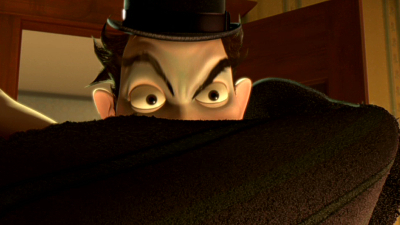
While Doris winds up being the hidden but main threat, the attention has been thrown upon Meet The Robinsons’ nominal bad’un, the Bowler Hat Guy. In truth, he isn’t one of the greatest villains, as he was widely promoted as: where he fails is in not actually being evil enough, or able to carry out his plans. He’s a scheming nincompoop, not scary, and therefore not as effective as other human rogues such as a bitter Lady Tremain, dog-killer Cruella De Vil, child-abductor Madam Medusa or even bad butler Edgar, which he probably resembles closest. However, as the work of a superb melding of oily Terry-Thomas type pantomime scoundrel elements (from all those mustachio twiddlers from The Perils Of Pauline, though Dick Dastardly, Oil Can Harry, Jack Lemmon, in The Great Race, and so on) and spectacularly slick and fluid animation, on an entertainment level he’s absolutely first class.
Apart from Anderson’s baddie, the rest of the voices deliver pleasing performances, largely from a cast that’s short on big overwhelming poster names and more in line with being right for the part. I enjoyed all apart from Wilbur himself, who came over as being too old, and possibly Lewis, who was too whiny for someone with a never give up attitude, and there was also the question of why a male performer (Anderson again) plays the part of the Jane Jetson-esque sister Tallulah in the future, which I couldn’t make out a discernable reason for, and pondering this made me realise that I didn’t think the dialogue was particularly well written overall. The movie has great moments, though, such as Bowler Hat Guy’s attempts to tame and command a giant T-Rex dinosaur, lending the film its stand out comedy moment and the line that got repeated ad infinitum in the previews: “I have a big head, and little arms!”
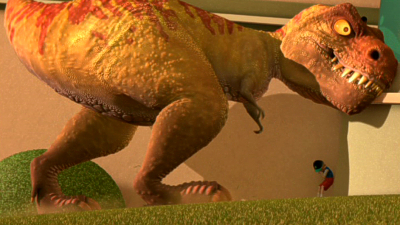
I still feel that some parts are rushed or don’t have enough depth to them, while others try to pack too much in; some sequences go on for too long or don’t have a reason to be there. Most of the second act – meeting the Robinsons themselves – are elements I recognise from the book, but with a book one can read and turn the pages at their own pace, not being as so frantic and allowing the artwork to work its own charm. This is why further viewings are a must. We simply don’t spend enough time with the titular family, since the movie zips around so much, but (as with many films with final twists) time travelling back to see it again allows us to psychologically build on what we soaked in before and fills in the logic to forgo any of these issues.
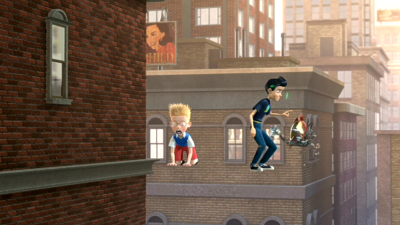
Meet The Robinsons, then, is certainly more wondrous when seen again, where characters with little emotional impact can present themselves anew, and not least because the fates of heroes and villains are both known up front, allowing for these extra new angles to play with a completely alternative perspective for the audience. It’s just ironic that the middle of the movie – the titular meeting of the Robinsons – is overly frantic, perhaps too much so, and in the attempt to withhold plot information in order to deliver the emotionally charged knockout punch ending, much of the first half of the film is filled with apparently pointless diversions that can be close to irritating for an audience to bother with. Robinsons does come close, at times, to having an uneven quality that jumps between pure storytelling (Lewis’ journey) and the need to be overly contemporary (in many ways, his destination).
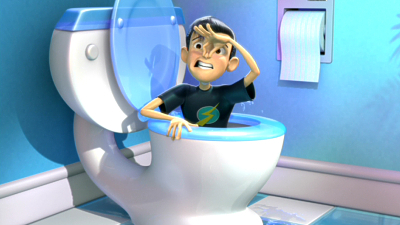
Any unevenness experienced in Robinsons could well be put down to the Pixar effect – it was during production of the film that Disney acquired the company and its chief John Lasseter urged a reworking of the film, pushing back the release a few months, though apparently bringing Anderson’s personal comparisons to Lewis’ situation to the fore. It’s possibly this late tinkering that helped the third act so much, even if I’m still not quite sure it’s not a cheap move to use one of Walt’s philosophies to whitewash the move to CG-created features (“Keep moving forward”), a justification by bribe, if you will, via direct words from the man himself. However, with all the talking animals, cars, bugs and penguins that continue to star in such fare, it feels fresh again just to be able to return to good old human family values, and Meet The Robinsons gives families a very good reason to sit down together again.
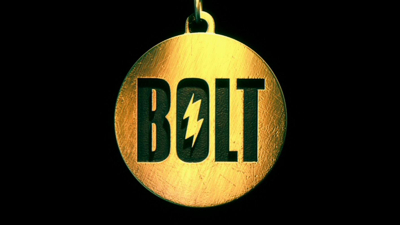
Bolt (96 mins, 1.78:1, Rated PG)
Until the 2007 Academy Awards nominations were announced, absolutely no-one expected Disney’s Bolt to feature that strongly in the three available slots. The general widespread thinking was that Pixar’s WALL-E had it in the bag, that DreamWorks’ surprisingly layered Kung Fu Panda could bring along some strong competition, and that the animated documentary Waltz With Bashir or Blue Sky’s Horton Hears A Who! could cause an outside chance of upsetting the odds. In the final eventuality, Horton proved to be released too early for anyone to remember and Bashir waltzed off into the Foreign Language category, the final spot leapt into on all fours by Disney’s latest canine star.
Despite polite reviews and generally decent box office, Bolt didn’t exactly set Disney’s shares soaring on original release, and an no-one was expecting an Oscar nomination, an extra surprise given the production’s history, which famously started out as director Chris Sanders’ follow up to his blockbuster smash (and later lucrative franchise for the Mouse), Lilo & Stitch. Originally called American Dog, Sanders’ basic concept was about a dog of a certain ability who gets lost in the real world and has to find his way home, while nefarious forces conspire against that goal.
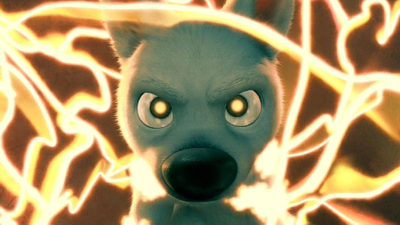
Those that saw the original artwork saw a completely new kind of feature threatening to emerge from Walt Disney Feature Animation: on of innate beauty and absurd quirkiness. However, by most accounts (or at least the officially Studio sanctioned one), the unique visuals couldn’t hold up the not so interesting story, though I like to imagine that the story was just as out there as the look. Whatever the situation, when Disney merged with Pixar and new head honcho John Lasseter didn’t like what he saw (maybe it was all too original?), Sanders was out and a pair of rookie directors (Chris Williams and Byron Howard) were in. A couple of name changes (the Studio unit to Walt Disney Animation Studios, the movie to Hollywood Dog) later, and the production was underway again, now about a German Shepherd acting pooch who gets lost on location and has to find his way home.
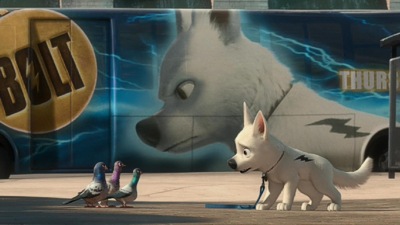
Sanders’ creepy villains were also dropped, the movie now carrying the bland message that if you believe in yourself, you can do anything, and although comparisons to Disney’s own direct to video outing 101 Dalmatians II: Patch’s London Adventure are perhaps unfair, they’re unfounded either. The reworked movie’s plot shares several similarities, from the German Shepherd star, Thunderbolt, who thinks his movie set life is the real deal, to having to draw on his real strength to fight back – points that became all the more convincing when Hollywood Dog was again retitled…to Bolt!
None of this seemed to matter when the movie opened in theaters: not only did Bolt open stronger than expected, but it had legs, performing above average and gaining favorable reviews. Bolt was a better than moderate success and, generally speaking, The Mouse was rewarded with one of its strongest animated performances in years and validated placing its trust into Lasseter’s hands. Quite if Sanders’ American Dog would have performed as well, or better, than Bolt is a question to ponder forevermore: both films are as far from each other as they could get, and all we have is the evidence that Bolt was well on the way to returning form to Mickey’s outfit, confirmed by somewhat surprise Oscar nomination and one of the director’s promotion helming the modern classic Tangled.
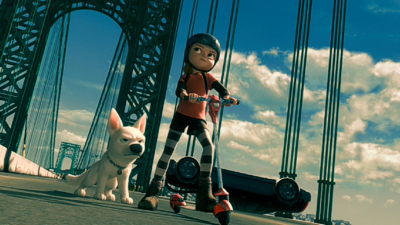
I can be said that Bolt delivers a harmless, good time. The opening certainly delivers: I had a huge grin on my face all through these initial scenes, which set up Bolt as the supercanine hero in his own Hollywood world. After a pre-title prologue in which we meet young pup Bolt and we see him adopted by a young girl, Penny, we’re then shifted five years later and literally dropped right into the mystery and action as Penny’s scientist dad calls his daughter to advise her he’s in trouble. Penny sets off to help, accompanied with her now power-charged pooch Bolt, now grown up and genetically modified with an arsenal of abilities.
Of course this is all make believe, set up for the hyperactive TV show where Bolt is the star, and it’s all played as delightful pastiche, from the over the top narration (“You won’t be alone…you have Bolt. I’ve altered him…”) to John Powell’s triumphant, brassy score motif that roars up when Bolt’s transformation and tag become the flashy instigators for the tongue in cheek main title logo. Then we’re straight in to a wonderfully histrionic sequence that could blow the doors off any in the Jerry Bruckheimer tradition (an ambition later confirmed by the directors in the supplements), full of high-tech gadgetry, threatening British-accented villains and black-suited, black SUV driving bad guys, and feats of super strength from our hero including a high-speed city street chase, daring leaps and rescues, laser eye vision and a mighty powerful bark, all presented with typical electronic musical scoring, elaborate camera moves, slow-motion shots and multiple angles of the same explosion, the likes of which you’d have expected to have been directed by Michael Bay!
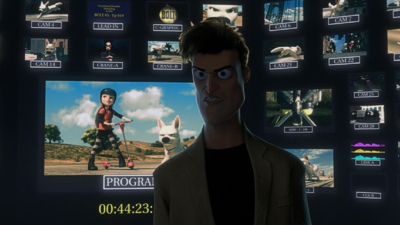
Unfortunately, this high intensity can’t be kept up for another 90 minutes, of course, and the rest of Bolt simply fails to make much of an impact. With the action cut short by a stray boom mic being caught in shot – something that could ruin the illusion for the show’s star actor, Bolt himself, who thinks this is all real (this being another one of those “millions of hidden cameras” capturing the action type deals, but we’ll let that slip) – Bolt slides into a sub-Pixar mold that doesn’t play to all its strengths.
The basic plotting doesn’t fall into place as it should, Penny herself being an enigmatic character that has to be one thing for Bolt and the plot to work as best it can, and another thing for the audience, the result being that we’re never quite sure who the real Penny is and why she feels the way she does. Her character isn’t helped by being played by Disney moppet of the (then)-moment Miley Cyrus, a late replacement and seemingly picked just for star value. Certainly these current in vogue stars are as interchangeable as they come but, tween audience demographic apart, Cyrus is all wrong for the part.

During the otherwise exciting opening scenes, Penny’s vocals are the one thing that feel lifeless and devoid of any such involvement in what is happening, while she just sounds too old in the post-TV show moments – indeed a “replacement Penny” that appears later in the movie is much more appealing. It’s something that doesn’t help her animation overcome the further rather bland character design, either. As our titular hero, John Travolta is more successful, and though he too is in danger of not fitting his role like a glove, he at least brings the right kind of acting chops to the game.
Travolta, whom we don’t actually hear speak until almost twenty minutes into the movie, does what he can with the script, but its clear there are no improvisational sparks flying around, and an early scene where Bolt’s co-stars mock his belief in his powers feels awfully second hand, though the digs at Hollywood, and especially a greasy talent agent, are quite fun and so near the truth it hurts! Other than this, the vocal highlight has to be the introduction of three New York wise-guy pigeons, though even here we’ve seen the basic same play before in Animaniacs and despite the quite brilliant animation and some of the best lines given to any of the characters in the film, it’s another element that stops Bolt from feeling like anything truly original.
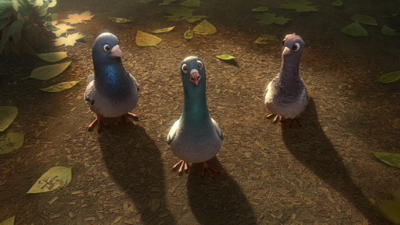
Elsewhere the animation is an odd mix of Pixar-level tone and sometimes quite embarrassing low-rent stuff. The look of the movie is sheer class, Chris Sanders’ watercolor-preferred styled backgrounds somewhat retained with a computer generated painterly approach. It mostly works but can also come over as not being one thing or the other: the visible paint strokes on objects that also feature definable textures not always meshing as best they might. I also noticed some of the background detail jumping between inconsistencies: there’s a whole sequence set in some lush greenery, but not one blade of grass or tree leaf blows in the wind. Now one might think this to be a stylistic choice, but check out other areas of green in the film and they sway as they should.
Of the characters themselves, I’m not sure if Bolt’s proportions actually work, and he does seem to keep changing size, however subtly, throughout the film. However, a more noticeable issue, and pegging the film down from the lofty levels of a Pixar outing, is the duplication of the background human models. Although even The Lamp’s productions have to come to terms with “crowd control” or “people police” in the number of unique individuals they can create for any given scene, more often than not in Bolt, you’ll see the same men show up time after time. These aren’t supposed to be the same guys – it’s just a limitation of the budget and, I guess, the time the rushed production was completed in – but instead of coming up with the usual variables in costume and hair design, they’re pretty much a carbon copy clones popping up time and again.
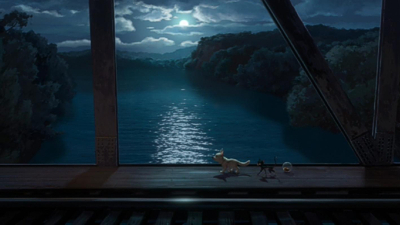
You might understand or even expect this in the product of a lesser Studio, but in a Disney movie overseen by Pixar’s Lasseter? Elsewhere the Pixar touch is echoed in the lack of an actual villain: once Bolt breaks free of his Hollywood confines – an admittedly amusing sequence where the posters on the network’s walls suggest the ones finally used in this very movie’s marketing – the TV series’ bad guy, the mysterious Green Eyed Man (deliciously overplayed appropriately by Malcolm McDowell), obviously has no place in the “real world” story…but then, it seems, neither does any other opposing force. True to Pixar form, the film becomes a road trip, full of varied characters but none of which pose any true danger or threat to Bolt’s quest to return and – he thinks – save Penny.
This not only robs the film of any real character depth but a few missed opportunities: how about Bolt spotting a character that resembles the Green Eyed Man, leading him away from his goal purely unwittingly after perhaps coming so close to being reunited with Penny? Or even a rogue dog-napper who hears about Bolt’s escape and chases the pooch for a potential reward? It just seemed to me that Bolt is happy to forgo any actual exciting or interesting plot diversions along the way, falling into the episodic trap that so many of the 1970s Disney films were (sometimes unfairly) accused of. Maybe it’s this playing safe attitude that had an effect on the scripting: much of the banter between characters is obvious and seemingly recycled, and several personalities, such as the Hollywood agent and Rhino the hamster, seem like they’ve been pulled from some old stockpile.

In fact I found Rhino himself – otherwise seemingly the break out character – to be quite irritating; sometimes funny, always amusingly performed with some of the best lines, but indicative of recent Disney’s loud sidekicks in that they seem to have to shout all their dialog in an attempt to amp up their impact and comedic assets. Best of the lot is Mittens, a black cat that Bolt leashes himself to in an attempt to find Penny, who remains calm and realistic throughout, a much needed balance to Bolt and Rhino’s over-exuberance. Eventually, Bolt comes over as a patchwork mismatch of varying ideas and techniques; elements that would probably work on their own but that don’t always come together in a harmonious whole.
The film is engaging enough, but the Best Animated Feature nomination still surprises me: maybe it was a goodwill gesture towards the newly invigorated Walt Disney Animation Studios crew, even if it wasn’t really deserved until Tangled, which ironically and disappointingly didn’t make the Academy’s cut. We can only wonder what Sanders’ American Dog might have turned out like, but it wouldn’t have been this film: the two couldn’t be more further apart in tone or execution. Slightly overlong at 96 minutes, Bolt does have its moments – a final fire rescue in the studio complex resolves our hero’s arc satisfactorily if not spectacularly – but ultimately it’s a pleasant enough diversion that comes recommended as a typical slice of slick, CG filmmaking, if nothing more.
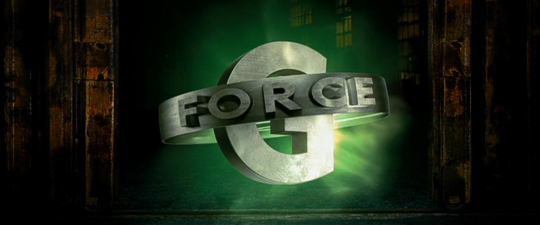
G-Force (88 minutes, 2.40:1, Rated PG)
And so we go from a Disney movie that spoofs the current Jerry Bruckheimer action blockbuster model to one actually produced by the man himself! Apart from the high-sea faring fourth entry in the blockbuster Pirates Of The Caribbean franchise, the Disney Studios’ long partnership with the legendary producer has been riding some rocky waves of late, with a handful of big-budget, intended blockbusters falling at the box-office hurdles. In particular the two-handed combination of The Prince Of Persia, another video game based movie, and the frankly dire The Sorcerer’s Apprentice, which ruins not only Mickey’s immortal moment in Fantasia but original composer Paul Dukas’ story as well, were the second and third strikes in a trio of duds that had started with the animation/live-action G-Force.
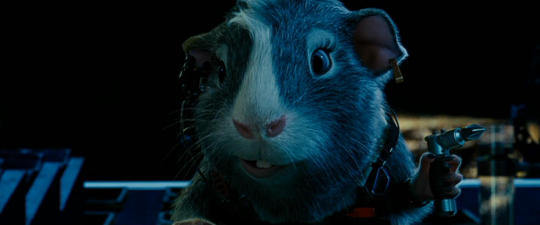
Bruckheimer has been a producing powerhouse for around thirty years now, first with his hellraising partner Don Simpson at Paramount and then, when Paramount’s executive dynamic duo of Michael Eisner and Jeffrey Katzenberg moved to the Mouse House in 1984, he soon joined them, after Simpson’s untimely death, and has continued to call Mickey’s kingdom home ever since. Mainly focusing on producing the same kind of adult action fare for the Studio’s Touchstone Pictures that had served him so well for many years, the Disney influence finally began to make dents in Bruckheimer’s action armour in the 2000s, when his name began to show up with increasing frequency on films also bearing Walt’s name, the National Treasure series and the Pirates Of The Caribbean franchise being the standouts.

Bruckheimer even eventually went animated in 2009 with the CG-enhanced G-Force, which after months of a lack of accurate news reportage on the project turned out not to be an update of the old Japanese cartoon Gatchaman (aka Battle Of The Planets), but a very enjoyable hybrid adventure that was widely overlooked at the box-office (though it has become a strong holiday seller on DVD), suggesting to many that Bruckheimer had lost his touch, the increasingly formulaic aspects of his action fare also adding fuel to that fire and, as we have seen with Bolt’s high-tech, hyper opening, even threatening to become parody fodder. Actor Alfred Molina proved to not be the only thing memorable about the following two Disney/Bruckheimer releases: both Prince Of Persia and Sorcerer’s Apprentice were marked down in Hollywood history as “disappointments” both creatively and commercially.
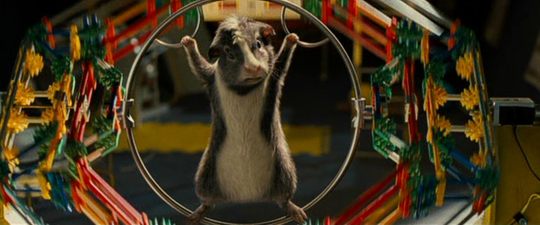
In Persia’s case, it was a surprising lack of action – especially from a video game translation – that dragged the film down into the sands of time, but Bruckheimer was all too happy to let Disney’s marketing department take the blame for it and Sorcerer’s underperformance. I don’t think that releasing two similarly aiming films within weeks of each other helped either film’s chances, but with G-Force also having received a collective shrug by the audience, it unfortunately led to the sad departure of long time Mickey-mouska-marketeer Dick Cook. Neither is it fair to blame an outgoing regime for poor film choices: surely the filmmakers themselves should accept the majority of the responsibility for essentially making dud movies?
By all means blame the poster tagline (as Bruckheimer did for the poor showing of Apprentice), but a decent film would have generated better word of mouth for a start, and no-one can say that a producer of Bruckheimer’s significance didn’t agree or sign off on any such tagline. In the long run, the disappointing box office fortunes of Prince Of Persia and Sorcerer’s Apprentice – which no one could say were not sold as a solid family adventures “from the producer of Pirates Of The Caribbean or National Treasure” respectively, no less – both turned out to be warranted, and despite plenty of rip-roaring spectacle and attempts to make everything seem “amazing”, neither film were enchanted classics by any means.
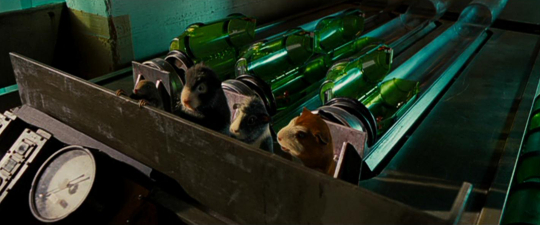
Which is why it’s a real shame that G-Force usually gets lumped in with this trio of Disney/Bruckheimer releases that both would probably rather be left forgotten, because it actually offers some top-drawer action and excitement for all members of a family audience to enjoy, unlike the majority of the live-action with computer animated animal pictures we keep getting forced to endure and that this is undoubtedly Disney’s answer to. But then it’s actually interesting to note that G-Force isn’t really a Disney Animation production at all: its CG images being animated and rendered by the visual effects and animation artists of Sony Imageworks, the same teams responsible for the likes of Sony Animation’s Surf’s Up.
Quite why Disney didn’t handle the animation in-house hasn’t been explained, but Imageworks certainly has form when it comes to animating animals even if they can’t generate realistic human effects and, whoever the vendor, the animation is as absolutely superb as one would expect from any release with the Disney badge on it. The movie itself is nuts, featuring a small band of guinea pigs, and their mole associate, who perform their duties as a highly trained band of miniature secret agents with the assistance of their human contact, played by Zach Galifianakis. Of course, this being a typical kind of new Hollywood kids animation movie, the characters all have superstar vocalists providing their dialogue.
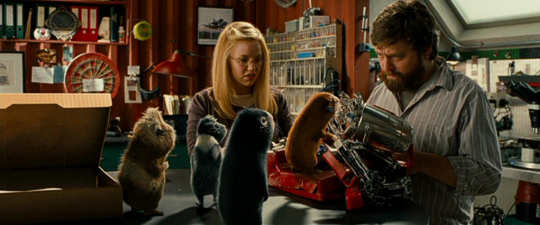
Chief among these is Bruckheimer’s National Treasure buddy Nicholas Cage, with others in the cast being performed by the producer’s other alumni Steve Buscemi, Penelope Cruz, Sam Rockwell and 30 Rock’s Tracey Morgan. Although this might sound like celebrity voice overkill, it all plays out pretty nicely, the actors clearly having fun with their roles and the characters scoring higher as a result of having recognisable, relatable vocalists, much in the same way that Tom Hanks and Tim Allen brought instant personalities to cowboy Woody and Buzz Lightyear in Toy Story. Especially good is Cage, pulling off a bizarro nasally accent that’s bags of fun and initially kept me guessing who was providing the vocals, and Cruz, who manages to find an English-speaking role that plays on her alluring Spanish accent with much more authority than her more recent and awkward appearance in Pirates Of The Caribbean: On Stranger Tides.

The plot itself is sheer by-the-numbers standard spy stuff: Bill Nighy is a Jobs/Gates industrialist about to unveil his super-secret computer microchip that will enable all machines to communicate with each other, supposedly for man’s common good. But of course there’s a ghost in the machine, and Nighy could well be planning something else entirely… In a totally irregular but no less spectacular fashion, G-Force is sent into action – or rather they escape their unit’s shutdown to crack the case themselves and thus prove their worth – and despite the somewhat predictable plotting there’s much fun to be had with the miniature adaptations of generic spy staples and gadgetry.
If there is an angle to the movie that doesn’t quite convince as much as it could, it’s in Nighy’s villain, who ultimately doesn’t get a big ending, though that’s as much down to the ultimate mastermind behind the overall scheme as it is the storyline, and on the flipside it’s pretty cool that the real bad guy doesn’t switch sides last minute and genuinely gets what’s coming to them. The important thing here is the journey the characters take, and it’s a highly enjoyable one. Okay, so G-Force isn’t the greatest Disney movie to emerge in the past few years, but it’s one of the most consistently entertaining. And it’s also refreshing, in this world of CGI blunders, that G-Force is a live-action/animation hybrid picture that brings new characters to the screen as opposed to desecrating the memories of such loved classic animation stars as Scooby-Doo, Garfield or Yogi Bear.

As a typical Bruckheimer actioner, it’s naturally more lightweight on any sex and true violence aspects, but adults with a young heart should get just as big a kick out of it as from the likes of Enemy Of The State, Con Air or Armageddon. As a Disney family movie, it’s different enough to feel fresh and certainly it’s been made with top of the line production values intact, not least in regards to the animation that keeps the highest Disney ideals in place even if Sony handled the actual movement and interaction. But it’s also nice to see that the spy pastiche format doesn’t have to feel old and stale, as much as it has in too much recent CG animated fare where even the mighty Pixar stalled with this summer’s Cars 2. G-Force, then, is the best of both worlds: a high-octane blockbuster adventure coupled with typically top-drawer values.
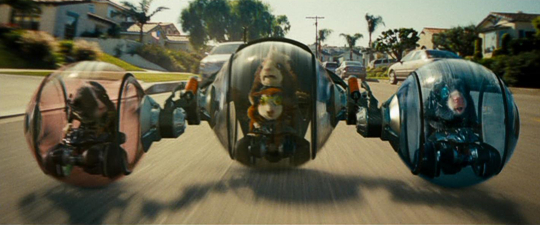
Sure, it’s a big furball of Studio fluff – in more ways than just one – and even though it’s not technically a Disney Animation movie, or even a straight animated movie when it comes to it, G-Force could actually be in danger of being the most recommended film of these four picks, at least in this reviewer’s eyes. Certainly not deserving its box-office reception and reputation, it’s disheartening to know that something like Beverly Hills Chihuahua earned more in theaters and warranted a video sequel when there are surely more adventures to be had with these little guys. Like GhostBusters, G-Force comes over as a bunch of moviestar friends just hanging out, having fun and, as opposed to refusing admission to a private party, thankfully inviting us along for the ride!
Is This Thing Loaded?
As (nearly) always, Disney’s Blu-ray 3D discs in all four of these sets contain next to nothing by way of bonus features, and although I understand why they’re slowly letting the regular copies of these titles run out of stock to be replaced by these “all-format” combo packs, I can’t see why they don’t just put out single-disc issues of just the 3D platters so that collectors aren’t paying out for content they already own (updated previews aside, the regular Blu-ray and DVD discs are the same as have already been released). So, there’s nothing on the BD3Ds themselves, but how do the other discs stack up…?

Chicken Little:
Back on original release on DVD and despite a fair box office pull, Disney’s CG comedy didn’t seem to warrant the regular full-on supplement treatment, and was accused of holding back pretty standard extras such as a director’s commentary exclusively for the then-concurrent Blu-ray release, seen as using the tactic to force fans over to the new format much as Disney has done again recently by packing Pirates 4 and Cars 2 with supplements only in their 3D-formatted editions. A traditional double dip was assumed, then rumored, but ultimately failed to show. One might have thought Disney could have used this opportunity to sprinkle some more in, but no such luck here: what we get are the same Blu-ray Disc and DVD as before, now joined by the 3D edition but no Digital Copy.
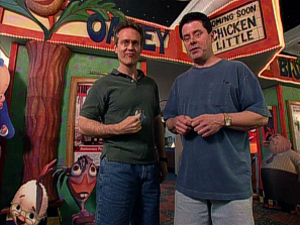
In these previously seen supplements, there’s nothing, of course, on the long production’s journey to the screen and the changes it went through, but welcome is a feature-length Audio Commentary with director Mark Dindal, producer Randy Fullmer and Visual Effects Supervisor Steve Goldberg that, despite Dindal’s laugh-a-second approach for the movie, turns out to be a healthy discussion that considers a variety of technical and story issues that were tackled during production. In fact, not having visited this track before since picking up the original BD edition after reviewing the standard DVD, I found it to be one of the best such commentaries of the past few years, and there’s very little that isn’t touched upon; a simply excellent track.
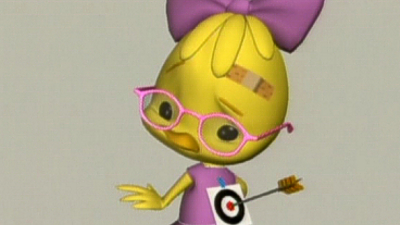
Just as good, and also exclusive to the Blu-ray is a Filmmakers Q&A option, as well as a text screen on how this works: basically you get to “ask” Dindal and Fullmer pre-selected questions throughout the movie, which pull up various audio soundbites and video clips in order to answer them. The basic concept of Disney’s later Cine-Explore can be found here, and it’s actually groundbreaking in its own right, with additional pop-ups asking if the viewer would like to learn more about a particular scene being a precursor to the extended interactive explorations of some of Disney’s other titles. Covering everything from Story & Script, Characters, Animation and Production headings, some of the questions may overlap here and there, but there’s also a ton of interesting info to be had.

Less essential is the early Blu-ray Movie Showcase feature, which simply strives to show off the format by playing selected moments from the movie – in this case three – that offer up typical home theater demo material. Another early push for the format saw the introduction of more interactive gameplay than DVD had been able to achieve, although these games have become far and few between recently. Here, an Alien Invasion Game is pretty good fun, basically being Space Invaders but with the Chicken Little characters aiming their weapons in the air to blow up the encroaching spaceships. It may come over as slow playing to those weaned on videogames but it’s lightyears ahead of anything created for DVD, and the playability is really interactive via your player’s remote. The only annoying thing is the looped score music which can quickly drive you nuts!

Mixing older and newer extras are a series of “all-new” Blu-ray and Original DVD Deleted Scenes, with or without Introductions from Dindal and Fullmer, and running almost a full half-hour in total. A fully-animated pep-talk from Mayor Turkey Lurkey is absolutely lovely, with a wonderfully warm reading from Knotts. I can’t get enough Mayor Lurkey so I’m probably biased, but I’d have loved it if this had been in the movie, while a storyboarded apology from Buck Cluck harks waaay back to offer a look at how the movie might have looked if ex-Disney honcho Michael Eisner had continued his insistence that the hero become a heroine (before being changed back again), there was still a Mother figure in the mix, and the temporary vocal suggests Danny DeVito was in the frame to voice Buck.
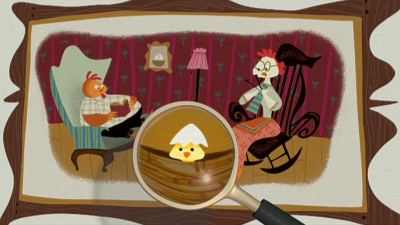
There’s more girl-Little in another brief, ultimately inconsequential moment, while we’re back to boy-Little for a talkative Lunch Room scene that was later switched to the dodge ball class to amp up the visually energy. Of the original DVD’s extras, Don Knotts reads over an alternative, fully animated old-school storybook opening, which I still believe is a much warmer beginning to the movie; hearing Knotts’ delightful delivery adds some poignancy too. The scene was dropped to show Chicken Little’s acorn-mishap happening for real, and with much more hyperactivity, in the movie’s opening, though this is a very sweet nod to the Studio’s animated past (including a very familiar Ducky Lucky) and, as a transfer over to CG animation, it’s a shame that at least its first half couldn’t have been worked in to the film up until the moment Little screams for help.

A second alternate opening is a strange one that even Dindal and Fullmer admit was a bad idea! An attempt to brighten up the Buck Cluck character from coming over too “mean” in the final movie, the sequence grew out of proportion until it was too big for itself. Though there are some neat shots in this moment of Cluck whipping up breakfast for his son, its clear why the mostly animated but not all rendered section was cut, though it does introduce the final opening in the movie and somewhat explains the “hand held news camera” style of the finished scene, also revealing where much of the movie’s initial theatrical teaser came from (trust Disney not to let unused but expensive finished animation go to waste).

The last alternate opening included switches back to girl-Little to show how the film would have opened with this much more paranoid and timid character center stage, while a final storyboard scene introduces the characters of Runt and Fish with a little more background but not much else. Also from the DVD, what seems like a potted documentary, Hatching Chicken Little, runs just over a concise and packed 18 minutes when one selects the Play All function. These five behind-the-scenes clips cover the development (using some of the deleted scene material as well as girl-Little tests), the cartoony look in CGI (note all of the competing studio posters on the animators’ wall!), voicing (with footage of the cast in the vocal booths), music (from Debney’s score to the songs and the Barenaked Ladies), and Dindal’s directing style.
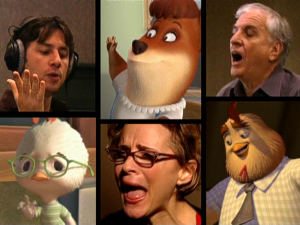
There isn’t really much we haven’t heard or know from before, and little left out that could be expanded upon in any great detail, but there isn’t much time for anything other than soundbites from Dindal and Fullmer. There’s a brief bit in here about Little’s early concept transformation from boy chicken to girl chick and back again on Eisner’s orders, but this is about as close as we get to any of the not-so-secret production bumps the film had along the way and, even though he has left this particular nest, Eisner comes out of it well as the filmmakers’ shoulder the blame for the switch.
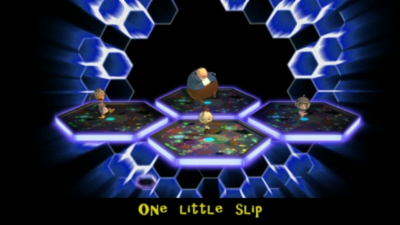
A Where’s Fish? trivia game has been dropped understandably, leaving Music And More to succeed in making one very tired very quickly of the Barenaked Ladies’ one-time Oscar hopeful theme song from the movie. We get One Little Slip three times (all at around three minutes): once as a live-action music video and twice as the same animated karaoke and sing-along clips with included lyrics on screen. There’s also the Disney Channel Cheetah Girls’ video clip (again at three minutes) for their end-credit version of Shake Your Tail Feather (geddit??), which is a little more ambitious than the Barenaked Ladies recording studio-set video, but not by much.
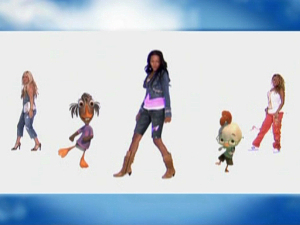
Rounding the disc out are a couple of Easter Eggs, which may be amusing depending on your love of the featured characters. These one-minute spots have Fish and Runt in the first and Foxy Loxy in the second, as they explain their take on the movie. Of course, this is as close to any publicity material we are presented with – the ’specially created teaser, theatrical trailers, very varied poster campaign (and its interesting logo changes) are all sadly left unexplored.

Meet The Robinsons:
Following Chicken Little’s lead, Meet The Robinsons’ initial DVD was a limited special edition that just about covered what would be expected without delving deep into the kinds of features collectors used to look forward to, while the Blu-ray release did nothing to add to that save for another interactive videogame. Topping the list again here is the full length Audio Commentary with director Stephen Anderson, who fairly warns any listeners up front that haven’t run the movie through yet that his remarks will deal with story spoilers. Keeping the chat up for most of the film’s 94 minute run time, Anderson is a little bit of a dry fellow, and though his thoughts are intrinsically fascinating (pointing out that Wilbur’s voice is a little older than originally intended), there isn’t much variedness to his voice and one may find themselves wandering off during the track.
However, it’s way unfair to criticise anyone’s natural speaking voice, so I’ll settle on taking a slight knock to the idea of Anderson’s character, the Bowler Hat Guy, breaking into the conversation in an attempt to liven things up. This actually is far from the fun it might sound, and is actually a little embarrassing: though the character is great and the accent comes through, there isn’t much to vocally differentiate each voice and it just sounds like Anderson being silly rather than an actual second character cutting through. But it’s done quite well, with a radio frequency effect interrupting proceedings, but the need for the director to then ask sound engineer Chris what just happened after each interruption just doesn’t work in the confines of the track.
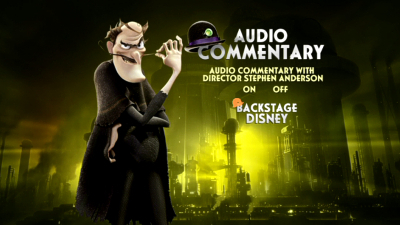
In short, those listening for the (lack of) entertainment value in Bowler Hat Guy’s moments in the track will find themselves bored by the straight technical and story development talk, and those paying attention to the otherwise strong production facts will find themselves annoyed by this silly gimmick. Anderson is obviously proud of his movie and has nothing but praise for his collaborators, showing little ego throughout, which makes it even odder that he couldn’t resist the idea of allowing himself to slip into character. Luckily, it only happens three or four times, but they’re peculiar, unneeded blips in an otherwise solid commentary. Not many of the in-jokes are pointed out, but while listening to Anderson’s remarks I noted a couple of neat ones based around the film’s two main authors: Lewis’ school is the Joyce Williams Elementary, and where he ends up is the old Anderson Observatory – sweet touches that further display subtly the sublime storytelling on show.

Sticking with alternate audio tracks, and once more there’s a totally unpublicised inclusion of a full-length sound effects track which presents the entire film sans music and vocals (hidden in the Audio Options of the Set Up menu). While this is the kind of thing Pixar used to like to include on their deluxe releases, I’m simply not sure how warranted this is here, especially when Danny Elfman’s full score has not been publicly made available apart from a crew-exclusive “thank-you” gift CD from director Anderson. Surely, with the following Elfman has, any space for such an isolated track would have been much better served in allowing his wonderfully unique and original music score to shine instead of a bunch of bells, whistles, crashes, whizzes and bangs? While this is of course meticulously assembled and showcases the intricate sound editing, it’s only fascinating for a handful, and nowhere as valuable as a potential Elfman score – perhaps even with cue gap comments? – would have been.

An Inventing The Robinsons featurette provides the now customary production overview that seems to have become the norm on Disney’s discs. As usual, the expertly assembled featurette glosses over the four/five year history of creating Meet The Robinsons, here potted into just under 18 minutes. While the basics of the Studio’s working practices are now well known to any animation collector, and even though this documentary seems to touch on every element in bringing such a movie together, one can’t help but get the feeling that it only skims the surface and that there is so much more to be revealed. There are cursorary glimpses at early versions of the film, but nothing on the switch to Pixar’s John Lasseter influences, though William Joyce gets some welcome screen time – if nothing else, the film transposes his original designs to animation uniquely – as does the voice cast, composer Elfman, and songwriter/performers Rob Thomas and Rufus Wainwright.
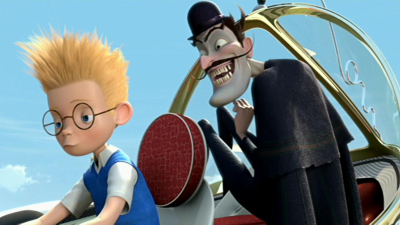
A peek at versions of scenes altered from how they appear in the final movie are among a series of six Deleted Scenes presented next, and double the number as appeared on the DVD. With introductions from director Stephen Anderson, who explains why and what was changed, the clips run for over 21 minutes in total. There are some strong lines in Arriving At The Future that could well have been kept in allowing for the change in direction towards the end of the moment, though Meeting Carl (the robot) was wisely shortened. exposes an entire sub-plot where the Robinson clan try to help Lewis’ self-confidence, with a nice line about parents that will strike a resonance later on, and it’s interesting to see the proposed wider widescreen framing. Best of all is an alternate take on Goob winning his baseball game, with a highly amusing additional line from Bowler Hat Guy that refers to his size and smarts over Lewis, and there’s a lengthy alternate ending in which Lewis glimpses his Mom that was wisely switched for the more emotional payoff as in the resulting movie.
Keep Moving Forward: Inventions That Shaped The World takes a six-minute look at the real life creators and developments that might have inspired Lewis himself, mixing a plethora of Disney images old and new. Presented in 4×3 standard def, it’s a rollicking ride through history, taking in such concepts as the first wheel, the printing press, telescopes and, yes, sliced bread, among names as famous as Edison, the Wright Brothers and…Walt Disney, of course, who gets a little company synergy plug for “inventing” the modern theme park, Audio Animatronics and EPCOT, though not his technical filmmaking innovations.
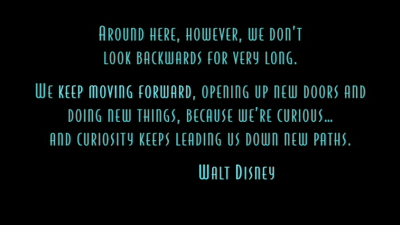
The Family Function 5000 Family Tree Game sets up trivia questions based on events and characters in the movie, though unless you didn’t put your brain on hold during the hectic central scenes you’ll be hard pressed to finish this one. In addition, The Bowler Hat Barrage!, like the Space Invaders-style game on the Chicken Little disc, utilises the kind of BD player technologies trumpeted loudly as the format launched but that now seem forgotten, and again plays like a classic aim-and-shoot arcade game.
Two Music Videos provide the promos for Rob Thomas’ Little Wonders (3:50), which explores the themes of the film in an odd 2.35:1 letterboxed 4×3 that crops off the movie’s imagery, and Kids Of The Future (3:20), performed by the Jonas Brothers, a reworded version of 1980s popstrel Kim Wilde’s Kids In America that may have you wondering what the point of it is (it’s not featured in the film, even in the credits). Finally, there’s another Movie Showcase, another early BD feature that again selects three demo-worthy moments from the main feature to show off the benefits of hi-def image and sound. Despite the highly visual nature of the film, there are no art galleries presented for our perusal and, naturally, Disney probably didn’t want to remind us of the lame marketing job they pulled out for Robinsons in theaters, so there are no publicity photos, posters or theatrical previews for the movie itself. Maybe it’s worth zipping to the future for the 40th Anniversary holographic cube quadruple dip edition that’s sure to include them?

Bolt:
Although not reaching the heights of the later Tangled, Bolt was widely praised as being something of a return to form for Disney and one might have hoped, with Lasseter’s supplement-loving clout behind it, for a pretty full package to be put together for the Studio’s latest star pooch, but the original release essentially came loaded only with the basics, and not much else, and that’s what we get again here. The main menu is slightly disappointing: a particularly simple affair that just presents a single screen of options (as opposed to the same release’s original DVD menu for which one still can’t help but wonder if someone was on a mission to rub Bolt’s Disney ownership into original creator Chris Sanders face as it suspiciously uses the new version of a much-seen concept clip from the original American Dog project).
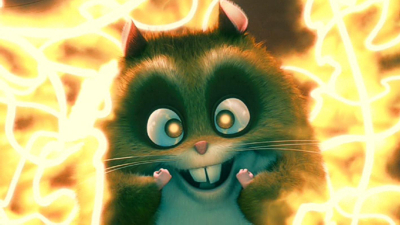
The primary bonus is the made for video short Super Rhino, essentially a throwaway joke – what would happen if Bolt’s hamster friend had gained super powers – that actually turns out to be a lot of fun, especially since it plays like more of the same from the opening minutes of the main feature. Here, Penny and Bolt have been captured by green-eyed Dr Calico, with hamster Rhino genetically modified to take on the bad guys and save the day. Whereas the character was close to grating in the film, as a lead here he’s too involved in the action to talk too much and so works in the way the gag is supposed to. Story supervisor on the movie, Nathan Greno makes his directorial debut with Super Rhino and it’s mostly down to his timing that manages to turn the short into a mega-pastiche of the modern-day action blockbuster a la Mission: Impossible or, more specifically, the over the top nature of the XXX movies. Running 4:30, even though it has its own main title and end credits, Super Rhino plays like many of the recent video short spin-offs: another short that doesn’t quite work as a stand alone film because one needs to know the situations from the movie to gain maximum enjoyment: short and entertaining as it is, it is a disc extra after all.
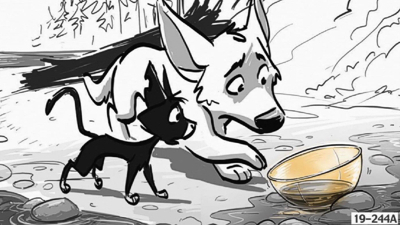
A couple of Deleted Scenes serve up two storyboarded moments from an earlier version of Bolt, with optional Introductions from directors Williams and Howard available in a Play All selection (6:37). Dog Fight In Vegas plays Bolt’s finding out he’s not a true superdog in an alternate, much more confusing and less effective way, while a River Sequence has Bolt trying to play hero again, but only just about saving a runaway Rhino by sheer chance. It’s not a terribly original scene by any means, but a highly exciting one all the same and which may well have been the badly needed mid-movie pick-up that Bolt the film would have benefited from in an action sense, and Bolt the character could have done with as a starting point to realising that true strength comes from within.
In In Session With John Travolta And Miley Cyrus offers a sixty-second bunch of talk from the two about how great they both are, followed by the resulting I Thought I Lost You Music Video (1:47), a typical studio versus clips promo which apparently is not supposed to be Bolt and Penny’s ode to each other, even if that’s how I – and I suspect everyone else – took it during the end credits. A Bolt’s Be-Awesome Mission Game again returns to the film’s best setting, the world of Bolt’s TV show, where the player can help our doggone hero defeat The Green-Eyed Man by working their way through a multi-level game based on the hand-drawn end credit styled characters. Although along the same lines as the Chicken Little and Robinsons games, the play here is more awkward and less fluid than a console effort, making the mission somewhat impossible even if it’s certainly more genuinely interactive than the standard DVD games of old.

The all too brief A New Breed Of Directors: The Filmmakers’ Journey might sound like an ultra-cool video diary of the production, but it’s just a usual fluff piece of studio-grabbed footage, the directors’ talking heads and a lot of John Lasseter bigging them up as the next best things at Disney. Williams and Howard actually seem likeable, switched on guys, and it’s always fascinating to catch a peek behind the scenes at where all the magic happens, but at just four and a half minutes, there’s barely even time here for a quick glimpse, the best we get being soundbites from a series of storyboard pitches, brief talk on how hard it was to tie two characters together via Bolt’s leash, and the fun the staff had in rolling around in an inflatable “hamster ball”.
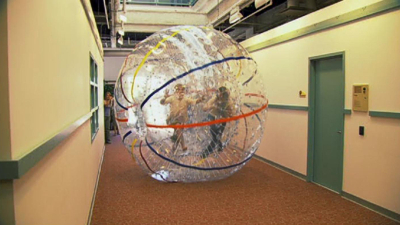
Act, Speak! The Voices Of Bolt is more of the same, this time jumping behind the microphone to join Travolta, Cyrus et al in the recording booth. Although Cyrus expresses her take on vocal acting as just like live action because “you’re still making all the faces and the movements and everything”, the following clips showing the complete opposite. Maybe she was over aware of the video camera recording her vocal performance, but she hardly puts anything into it, making a good visual argument for why her resulting lines in the movie sound so flat and uninspired. But of all the voice cast, everybody can’t help but fall over themselves in serving up superlatives on their colleagues’ work, which can get pretty treacly pretty quickly, though at least we get to spend a little more time with the cast in this almost ten minute piece.
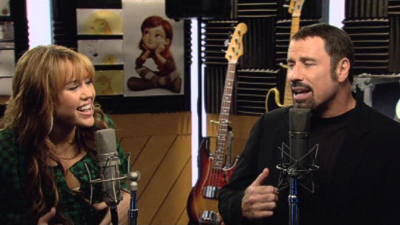
Again bypassing the whole visual development for American Dog, Creating The World Of Bolt takes a look at the painterly style of the movie’s unique backgrounds and how the computer animation was combined with this style. There’s a bit of talk about some early tests, which one might have to wonder were for Sanders’ version of the film, being that they’re shown in the wider 2.35:1 aspect ratio that he was aiming for. But otherwise, this is all very Bolt-centric and provides a decent look at how the artists managed to capture the various lighting moods of Bolt’s multiple locations, running almost to seven minutes. The Bolt disc doesn’t have a Movie Showcase option as per the previous two titles, but if it did then surely the opening ten minutes would be a perfect selection to show off any home theater…it’s just a shame the rest of the movie can’t really follow the full-blown high energy of the sequence.
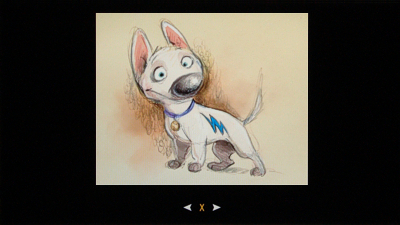
Also not included this time is a BD-Live Network link that seems to have been removed (good), but the disc does retain a Bolt Art Gallery that promises “a peek at the film’s early concepts”. Of course these early concepts begin and end with Bolt’s production and any talk of American Dog, even in a merrily glossed over approach, goes without mention. From sketches to maquettes and digital models, there are a good 250 or so images on offer, covering Character Design, Color Scripts, Storyboard Art and Visual Development, two of the most interesting being an early Bolt so close to One Hundred And One Dalmatians’ Thunderbolt that it would only have caused more comparisons to be made, and an intriguing early combination of Sanders’ Dog and the Bolt they ultimately went with.
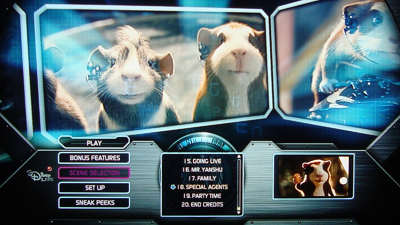
G-Force:
By now I’m sure you’ll know the drill when it comes to Disney’s array of supplements on disc – even for some Blu-rays – and some very specially selected titles apart we’re still a long way from the feature-packed two-disc editions that we used to look forward to on DVD. But, amazingly given the unfair middling box-office returns for the theatrical release, G-Force bucks the trend, the Studio perhaps deciding to splash out on a decent selection of extras in order to simply make the title a more attractive purchase, but instead giving fans of the movie what they really want in a quasi-collectors’ edition. Topping the list is an almost excellent feature-length Cine-Explore commentary with director Hoyt Yeatman, and I say almost excellent because he’s occasionally joined by a couple of the G-Force characters, Blaster and Darwin, who enter the sound booth and interrupt from time to time.
Although this could be a way in for kids to also enjoy the track, I’m never a fan of such intrusions as per the comments on Meet The Robinsons above, and Yeatman is otherwise engaged in the kind of information that collectors will appreciate more. Making up for the character hijinks, however, is a never-ending series of stills, images and background info that continually pops up via some groovy 24 CTU-style displays throughout, a sensory overload (in a good way) of information that uniquely often squeezes the movie back into a smaller box of its own much like Warner Home Video’s Immersive Maximum Movie Mode on some of their top-line Blu-ray releases. As if this wasn’t enough, at several times throughout the film, it will divert off in a series of optional “video files” that open up the movie making process further.

It’s a format that we’ve since seen developed more fully on Disney’s Beauty And The Beast and Bruckheimer’s own Prince Of Persia BDs, where these mini-featurettes are either linked to from within the movie or an overall documentary, or made more easily accessible from their own index. Here the index hasn’t yet been thought of, but selecting Cine-Explore with the video files option at least allows skipping through the chapters in order to catch these clips individually. Covering absolutely everything from the earliest concepts and stuffed animals for reference shooting, to the lenses and cameras used, visual effects, 3D and each of the vocal cast, these extra inserts last anything from around one minute to four or five minutes at a time. Character intrusions aside, if only every significant movie, animated or otherwise, was treated to this level of quality exploration.
The four-minute Blaster’s Boot Camp (4:41) is the disc’s kid-specific feature, a load of phoney baloney that gets us up to speed on the G-Force gang’s weapons of choice: fascinating to see for the level of detail gone into each element, but otherwise pretty pointless nonetheless. More interesting is a little more on the genesis of the movie in G-Force Mastermind (4:13), which originally came from a story made up by the director’s son: illustrating the length of time a movie can take to make, he was five when he came up with the idea and is eleven as seen here, a six-year journey to the screen. Although G-Force is Bruckheimer’s first semi-animated movie, Bruckheimer Animated (3:12) strives to portray the likable producer as something of a CG pioneer, a bit of a stretch, as is his assertion that this is the first time Disney 3D has emerged out of the frame, but it’s still an impressive résumé.

Access Granted: Inside The Animation Lab (7:52) further expands on the “sketch to screen” journey of the characters, although it’s much more interesting than just that, taking us on an exclusive tour of the Sony Imageworks studio campus and explaining that they landed the gig due to being able to provide character animation, visual effects and 3D rendering at a one-stop-shop. Pop-up facts offer a multitude of technical figures and it’s all more technical and surprisingly non-fluffy than we usually see when it comes to CG production featurettes, probably because of Yeatman’s visual effects background and his obvious enthusiasm for the process. Much less essential is an unfunny montage of “G-Farce Bloopers” (1:49), while a series of six Deleted Scenes are more like scene extensions and at only around a minute apiece don’t add much and come with a lack of context.
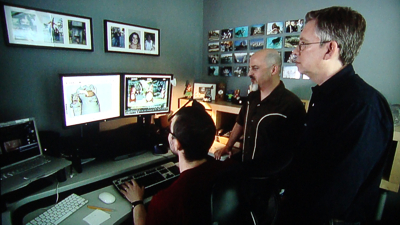
Finally, three Music Videos (8:24 total) feature promos for Flo Rider featuring Nelly Furtado’s Jump, a pop/R‘n’B crossover with a typically contemporary visuals intercut with movie shots, the rockabilly-like Ready To Rock performed by floppy-fringed Steve Rushton (who?) in a fun ’specially produced clip, and Go G-Force, the closest the set gets to offering true publicity material by way of new animation matched up to an end credit song. Naturally, and sadly considering how good the rest of the supplements are, Disney doesn’t include any of the teasers or the theatrical trailer on the disc itself, and it’s something of a surprise that we don’t really see or hear anything about Nicholas Cage’s involvement in the movie, but in all other respects the bases are covered nicely and although I haven’t checked it recently, there’s an assumedly redundant BD-Live link that might have once offered up a little more.
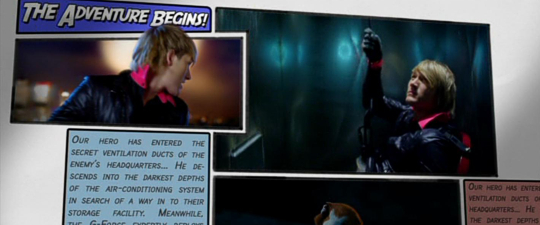
Roundup!
Included in each set is a standard definition DVD that basically replicates the original disc releases for these titles and feature a handful of supplements drawn from the Blu-ray extras, although nowhere near their amount. If you’re reading this, it’s likely you already have those discs, or even the initial BD releases, and already know what is (and isn’t) included. As the main point of interest here are the 3D discs and replicated Blu-ray platters, from which nothing has been removed, I’ll not drag out an already lengthy review and recover old ground.
Since these discs all find themselves coming to stores again on the same date, what is new across the various titles (except for G-Force, which keeps its old previews including the “new-to-theaters” Alice In Wonderland) and their multi-configurations are the updated Sneak Peeks, including Lady And The Tramp, Brave, Disneynature’s Chimpanzee, Beauty And The Beast’s Enchanted Christmas, The Secret Of Wings, Prep And Landing: Naughty Vs. Nice, The Lion King 2 and Lion King 1½, plus spots for Disney’s All-Access online library and Movie Rewards.
Case Study:
Largely retaining their original disc artwork, Chicken Little, Meet The Robinsons, Bolt and G-Force come to Disney 3D with the Studio’s now standard, but top-class, lenticular-fronted slipcovers making a big show of the multi-dimensionality inside the pack. In most other respects, the sleeves look much like they did before (this being third time around for Chicken and Robinsons, they match the more recent BD/DVD combos of a couple of years ago rather than Disney’s debut “swoosh” Blu-ray covers), but I still don’t get why “non-villain” Dr Calico is given such prominence on Bolt as he’s hardly in the movie. However, the lenticulars are an exclusive addition to the front of these packages, and I’ve yet to see one that doesn’t have some kind of cool factor.
Inside, there are the usual inserts promoting the benefits of Blu-ray and, more recently, 3D (though I still don’t get the promos here when we’re already holding the top of the range discs in our hands!), also containing the Movie Reward codes and booklets marketing other Disney product. Bypassing any reference to its Best Animated Feature Oscar nomination, Bolt’s front cover is still content to run with a “Best Disney film since The Incredibles” quote, someone obviously not telling Robert Butler that Brad Bird’s film was a Pixar movie! The primary BDs all contain color artwork on the discs, while the DVDs are their standard gray and gold picture-less selves, but as individual packaging goes these are pretty neat for what are ostensibly reissues.
It’s puzzling why only Bolt gets a Digital Copy, but on reflection it’s probably because the original release came with a similar portable device disc and so it didn’t need creating in the same way as would have been needed for Chicken Little, Meet The Robinsons and G-Force. The first ten minutes aside, Bolt is probably the film that would work best on a smaller screen, and so the inclusion is appropriate, though fans of the other films may grumble at having to resort to ripping the included DVDs for their own handy versions of the other titles.
Ink And Paint:
What’s crucial to remember with these 3D titles is that not one of them is a post-converted movie: all of them were created and released to theaters in this way to begin with. In a couple of instances, this is a blessing, but in the other couple, it can be a curse.
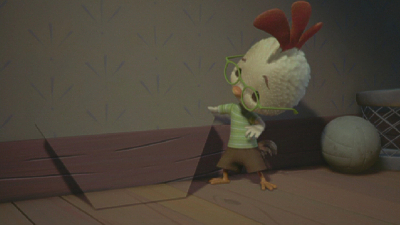
Chicken Little was an earlier attempt by the Studio at creating a 3D result and although there’s a lot of layering going on, with more incidents of elements flying out at us through the screen than animated films have widely settled on doing more recently, this is just its problem. With so much of a cartoony design and super-bright colors, Chicken is just too darn busy visually. Yes, this matches the completely insane approach of the movie, but it could be argued that the film is little more than an assault on the eyes and ears! On the other hand, it does unashamedly have straight down the line fun with its 3D, and if you like the movie to begin with you’re likely to get a bigger kick out of it. The regular flat BD also looks predictably great, and even if the framing still looks ever so slightly tight, the 1.78:1 ratio aptly recreates the theatrical experience minus the 3D imaging and, therefore naturally, a quick post-credit gag that had Chicken Little and Buck Cluck reaching out from the screen to pick up some leftover popcorn.

Meet The Robinsons is conversely more restrained with its extra-D, and perhaps a little too much so. Unlike Chicken Little, which while sporting true stereoscopic images was only awarded this distinction very late in production, necessitating a second-eye rendering after the movie had wrapped, Meet The Robinsons was designed from the outset with the 3D presentation in mind. Perhaps mindful of Little’s over exuberant visuals and the similarities in the high energy and visually packed central futuristic scenes in this subsequent outing, it does seem the 3D has certainly been dialled back, even if there’s still much more that drops into the audience’s lap than more recent CG 3D films have bothered to throw at us. The extra dimension only makes these scenes more frantic, however; it doesn’t help the emotional beats hit any harder and Robinsons looks just as appropriately sharp and colorful on its flat disc presentation, with an admirably high level of detail and texturing.

Bolt just about gets things right, adhering to the more recent school of thought in presenting more of a window on the animated world in which depth, as opposed to layers of dimensionality, is king. That’s not to say we don’t get a few bones tossed our way in terms of props, laser beams and hamsters in their protective plastic spheres flying out at us, although nothing ever feels like it’s really popping out of the screen in the way that Chicken Little and the recent, super-dimensional Tangled achieve. Those films, and Robinsons to stay true to comments on these reissues specifically, were all very bright – 3D animation’s friend – and the same can often be said for Bolt save for a couple of moments including the climactic fire rescue, where the lower light levels cause a little process ghosting, leaving the painterly style of the film’s backgrounds to be much better perceived on the flat Blu-ray Disc, where one can pick out the finer details, the lack of the 3D ghosting offering a super-expressive image that really bursts with energy. If anything can be said about the 3D, it’s that it does add an extra dimension of distraction to an otherwise rather two dimensional production.

G-Force, ironically, is perhaps the best of the bunch, surprisingly. Again the ghosting factor is something of a minor issue (where, given high contrast elements in darker-lit scenes, a faint “double vision” image might be perceivable by some viewers), but I would have expected the brightly-lit, pure animation titles, rendered out in the 3D format natively, to be superior to what is ostensibly a live-action picture with animated visual effect characters. I don’t know if the movie was shot with a 3D camera rig or whether the live-action footage was retro-fitted with the added dimension, but whichever way it was produced one can be sure the CG characters were at least natively rendered out in 3D. And this is where G-Force scores most, the amazing photorealism of the titular critters only helped by their feeling of solidness in the 3D presentation and their placing within the live-action world. I’d originally seen G-Force flat, and remain very impressed with that staging also, but it must be admitted that the 3D helps the integration more, although this could perhaps be because everything has a forced perspective look inherent in modern digital 3D and so marries the elements together more cohesively. The wider screen framing also adds to the dimensionality, with objects able to break both the letterboxed and display screen boundaries and, refreshingly like the movie, G-Force actually has fun with its third dimension.
Scratch Tracks:
Although sound is absolutely 50% of any moviegoing presentation, there’s always much less to be said about it when it comes to technically superior, big budget soundtracks that are routinely well produced, slick and perfect aural experiences. And that’s the case across all four titles here, which all get DTS-HD Master Audio tracks that are essentially ports over from previous releases, as well as various configurations of French and Spanish dubs and subtitles.
Chicken Little’s 5.1 mix (DTS on the 3D disc, PCM on the flat BD) is as loud and proud as one could want (or cope with!) and envelopes the viewer with an aggressive track for an aggressive movie. John Debney’s comically over-the-top (and therefore perfect for the feature) orchestral score spreads around the soundfield, but the use of contemporary stereo songs means those sections don’t jump out as much as they might (and I’ve never been a fan of scoring action scenes with rock songs), but the added bass here gives a bit of a kick at least.
Meet The Robinsons follows suit in 5.1, with DTS encoded for the new 3D disc and the same PCM track as before for the flat BD. Both push the effects and music elements well beyond what is normally required and let the dialogue breathe, especially in the overly hyper moments. Elfman’s highly energetic score is the undisputable highlight – making its lack of commercial CD release or isolated track here all the more unfortunate – although interestingly even the inserted contemporary songs sound richer; it’s as well crafted an animated mix as you’ll hear in any recent outing.
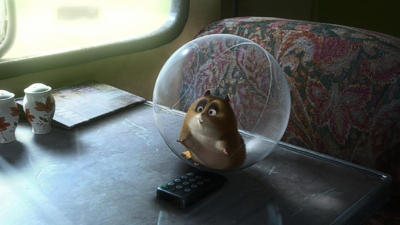
Bolt’s hyperactive, blockbuster movie pastiche mix is impressively huge in the 5.1 DTS track on both the 3D and BD discs, the sound effortlessly coming over as layered, variously textured, and with a distinct smoothness to the bass that’s sublime. One gets the feeling once again, however, that it’s a lot of bells and whistles applied to a rather bland movie, the standout naturally being Powell’s Bruckheimer-esque opening sequence. There’s also a D-Box code for those with the fancy motion-controlled chairs that put the viewer right in the action…would that be 4D?
G-Force, by comparison, is a Bruckheimer track through and through, with composer Trevor Rabin providing the MediaVentures-styled musical accompaniment to the action. But, try as he might to make a mark with his score, Rabin’s music is often swamped with everything else going on at any one time, from the exuberant voices to the whizzes, clicks and bleeps of the high-tech electronic gadgetry. It’s an exemplarily slick mix, the DTS 5.1 reproducing a big-room theatrical feel on the 3D and BD platters, and there’s an optional D-Box motion code here too.
Final Cut:
I must admit that I’m still not a firm believer in 3D being anything more than a gimmick that’s supposed to make some films “better”. Certainly none of these four films became more or less enjoyable because of any added extra dimension, and I’ve seen them all a few times each in various formats, both theatrically and at home. And I do worry that, apart from reissues of films originally produced in the format but only coming to 3D disc now, there is a growing trend of retrofitting older titles so as to rejuvenate them for audiences to see them with – no pun intended – a fresh perspective. It’s much akin to the Colorization process that was much criticized back in the day, but it seems the rush has already begun: in addition to Disney’s upcoming 3D reissues we’re to get all six Star Wars again annually from next year, and Jim Cameron’s Titanic is also set to sail once more (although maybe they’ll make that iceberg a little less one-dimensional).
But I just haven’t been that impressed with the technique when it comes to live-action films; it seems, to me, to be much better suited to the native 3D GCI medium, where Tangled remains the benchmark for me. I saw Chicken Little theatrically in 3D, and it’s still the loud, messy and overloaded movie it always way – perhaps even more so in 3D – and the same largely goes for Robinsons’ entire central section. Yes, there are funny nuggets in Little, and emotional resonance in Robinsons, but the 3D doesn’t add additional depth to those elements. Really, the same can be said for Bolt; its extra dimension is more accomplished but then the problem is that it is merely attached to…Bolt, a perfectly fine Disney confection but certainly the kind of title akin to The Adventures Of Ichabod And Mr Toad, Alice In Wonderland or Robin Hood: more than decent secondary pictures but secondary pictures all the same, and not an all-time Studio classic.
Chicken Little found Disney in sheep mode, being more of a follower than the leaders they once were before regaining lost ground more recently, and Meet The Robinsons is perhaps too quirky for its own good (possibly the result of eight screenwriters), but it does reward on repeat viewings. Bolt simply can’t maintain the velocity of its opening scenes, but remains an enjoyable enough comedy that’s typical of the CG routine these days. So it may surprise to find my vote of the four goes to G-Force, but I can’t help that I still find it a relentlessly fun adventure after three or four viewings, the specialist camera lenses entertainingly configured to the low-level critters’ eye-view. All four films are instant must-haves for Disneyphiles to add to their shelves, though perhaps only completists need to grab these reissues to make up their 3D collections. More casual fans may wish to rent to see if they think they’re worthwhile, but since most will already own them, it’ll be down to how much you love any given title before you consider adding the extra dimension.
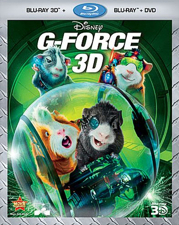 | ||
 |







